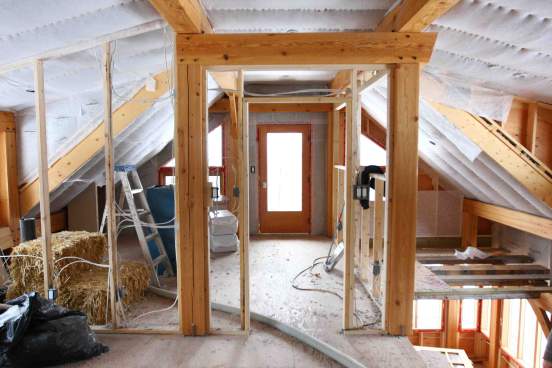
A warm hug from an old friend
There’s something about an old sweater. The kind that’s worn and maybe belonged to your dad or was a score at the local thrift shop. Something woolly, made from natural fibres, and hand-knitted. Something a little faded, greyed and stain
That’s how I feel about our newly insulated walls. Maybe it’s the journalist in me, but I can’t think of any better way to keep warm than to wrap your home in recycled newspapers.
OK, I know—you’re thinking, But I thought you insulated your house with straw? And we did. On three sides. However, our basement, south wall and roof are all stud framed and needed insulation. The question was, what?
Rock or mineral wool, known by its brand name Roxul, comes in batts similar to pink fiberglass insulation. Derived from rock and better for the environment than fiberglass (being green, it even looks better for the environment), Roxul is installed conventionally and covered with vapour barrier.
Another option we looked at was blown-in foam insulation. The benefit to blown-in insulation is, unlike the batts, it gets into every nook and cranny, rather than leaving small air gaps. However, it’s quite toxic when sprayed and, we found out after getting a quote, expensive.
Enter cellulose. Made from post-consumer newsprint mixed with borax to resist fire, insects and mold (we added borax to our plaster for the same reason), it’s a relatively benign product that’s also blown in, filling every crevice. Like our straw bale walls, it also breathes: instead of sealing it with vapour barrier, it’s held in place with mesh, allowing air to pass back and forth. The cellulose can actually absorb a certain degree of moisture and release it back into the atmosphere.
Cellulose could be ordered through our local building supply store, which in turn loaned us the machine to blow it in. Easy—and relatively inexpensive. Not to mention very cool: when you stare closely at a chunk of cellulose, you can actually pick out the tiny letters that were once someone’s daily dose of news.
Nick started in the basement, using rolls of burlap (left over from the wedding), which he stapled in horizontal rows to the studs. With each row of burlap that went up, he blew in cellulose behind it, packing it tightly to prevent airflow and settling over time.
When the burlap ran out, he bought local shops out of their remaining Reemay, a fabric most commonly used as a crop cover in gardens. The white, polyester fabric bulges with the weight of the cellulose from the ceiling in our loft, making it feel a bit like a circus tent.
Something about those bulging ceilings feels to me like a big, warm hug from someone I love wearing a ratty old wool sweater.
Over the holidays, we put our newly insulated house to the test: On Christmas Eve, we lit the wood stove and settled in for the night. The next day we were so cozy, we decided to stay another night. Five days later, we reluctantly moved back to the garage suite after our Christmas vacation.
Needless to say, we’re very pleased with our house’s insulation. It helps that, with the days at their shortest and the sun lower in the sky, sunlight now streams in through our south-facing windows and warms our plaster walls and soon-to-be earthen floors, radiating it back throughout the long evenings.
Apart from the benefits to us, let’s not forget the benefits of re-using all those newspapers: According to this University of Massachusetts website, insulating a 1,500-square-foot house with cellulose will recycle as much newspaper as an individual will consume in 40 years.
That’s a lot of Northwords. I’d better get back to work.
http://strawbaletales.wordpress.com/







